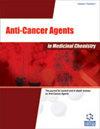A Green Synthesis of Au-Ag Alloy Nanoparticles using Polydopamine Chemistry: Evaluation of their Anticancer Potency Towards Both MCF-7 Cells and their Cancer Stem Cells Subgroup
IF 2.6
4区 医学
Q3 CHEMISTRY, MEDICINAL
Anti-cancer agents in medicinal chemistry
Pub Date : 2024-04-15
DOI:10.2174/0118715206296123240331050206
引用次数: 0
Abstract
Background: Limited chemotherapy efficacy and cancer stem cells (CSCs)-induced therapeutic resistance are major difficulties for tumour treatment. Adopting more efficient therapies to eliminate bulk-sensitive cancer cells and resistant CSCs is urgently needed. Methods: Based on the potential and functional complementarity of gold and silver nanoparticles (AuNPs or AgNPs) on tumour treatment, bimetallic NPs (alloy) have been synthesized to obtain improved or even newly emerging bioactivity from a combination effect. This study reported a facile, green and economical preparation of Au-Ag alloy NPs using biocompatible polydopamine (PDA) as a reductant, capping, stabilizing and hydrophilic agent. Results: These alloy NPs were quasi-spherical with rough surfaces and recorded in diameters of 80 nm. In addition, these alloy NPs showed good water dispersity, stability and photothermal effect. Compared with monometallic counterparts, these alloy NPs demonstrated a dramatically enhanced cytotoxic/pro-apoptotic/necrotic effect towards bulk-sensitive MCF-7 and MDA-MB-231 cells. The underlying mechanism regarding the apoptotic action was associated with a mitochondria-mediated pathway, as evidenced by Au3+/Ag+ mediated Mitochondria damage, ROS generation, DNA fragmentation and upregulation of certain apoptotic-related genes (Bax, P53 and Caspase 3). Attractively, these Au-Ag alloy NPs showed a remarkably improved inhibitory effect on the mammosphere formation capacity of MCF-7 CSCs. Conclusion: All the positive results were attributed to incorporated properties from Au, Ag and PDA, the combination effect of chemotherapy and photothermal therapy and the nano-scaled structure of Au-Ag alloy NPs. In addition, the high biocompatibility of Au-Ag alloy NPs supported them as a good candidate in cancer therapy.利用多多巴胺化学绿色合成金银合金纳米粒子:评估其对 MCF-7 细胞及其癌症干细胞亚群的抗癌效力
背景:化疗疗效有限和癌症干细胞(CSCs)引起的抗药性是肿瘤治疗的主要难题。迫切需要采用更有效的疗法来消灭大量敏感的癌细胞和耐药的癌干细胞。方法:基于金银纳米粒子(AuNPs 或 AgNPs)在肿瘤治疗中的潜力和功能互补性,人们合成了双金属纳米粒子(合金),以从组合效应中获得更好甚至全新的生物活性。本研究采用生物相容性聚多巴胺(PDA)作为还原剂、封端剂、稳定剂和亲水剂,报道了一种简便、绿色和经济的金银合金 NPs 制备方法。结果:这些合金 NPs 呈准球形,表面粗糙,直径为 80 纳米。此外,这些合金 NPs 还具有良好的水分散性、稳定性和光热效应。与单金属类似物相比,这些合金 NPs 对体积敏感的 MCF-7 和 MDA-MB-231 细胞的细胞毒性/凋亡/坏死作用显著增强。凋亡作用的基本机制与线粒体介导的途径有关,Au3+/Ag+ 介导的线粒体损伤、ROS 生成、DNA 断裂和某些凋亡相关基因(Bax、P53 和 Caspase 3)的上调证明了这一点。吸引人的是,这些金银合金 NPs 对 MCF-7 CSCs 形成乳球的能力有显著的抑制作用。结论所有积极的结果都归功于金、银和 PDA 的结合特性、化疗和光热疗法的联合效应以及金银合金 NPs 的纳米级结构。此外,Au-Ag 合金 NPs 的高生物相容性使其成为癌症治疗的理想候选材料。
本文章由计算机程序翻译,如有差异,请以英文原文为准。
求助全文
约1分钟内获得全文
求助全文
来源期刊

Anti-cancer agents in medicinal chemistry
ONCOLOGY-CHEMISTRY, MEDICINAL
CiteScore
5.10
自引率
3.60%
发文量
323
审稿时长
4-8 weeks
期刊介绍:
Formerly: Current Medicinal Chemistry - Anti-Cancer Agents.
Anti-Cancer Agents in Medicinal Chemistry aims to cover all the latest and outstanding developments in medicinal chemistry and rational drug design for the discovery of anti-cancer agents.
Each issue contains a series of timely in-depth reviews and guest edited issues written by leaders in the field covering a range of current topics in cancer medicinal chemistry. The journal only considers high quality research papers for publication.
Anti-Cancer Agents in Medicinal Chemistry is an essential journal for every medicinal chemist who wishes to be kept informed and up-to-date with the latest and most important developments in cancer drug discovery.
 求助内容:
求助内容: 应助结果提醒方式:
应助结果提醒方式:


